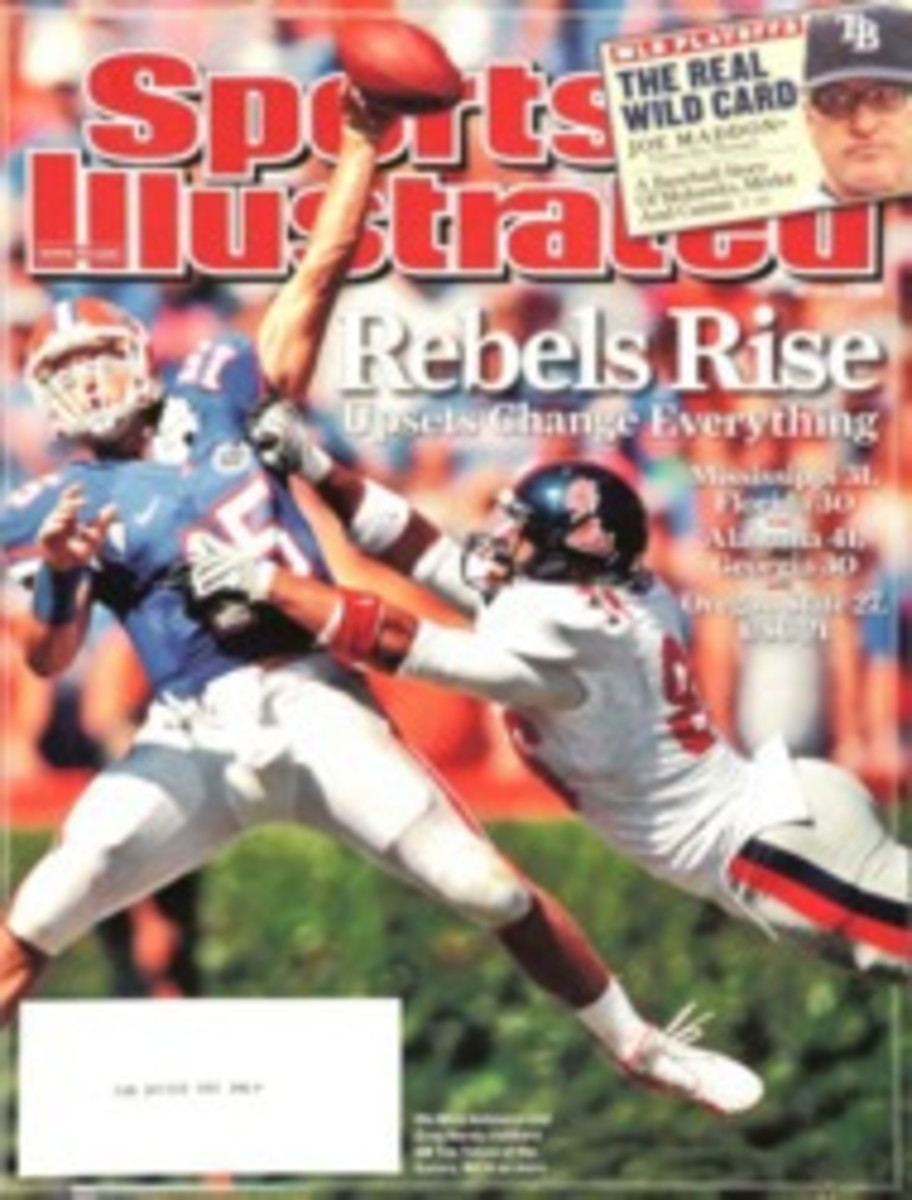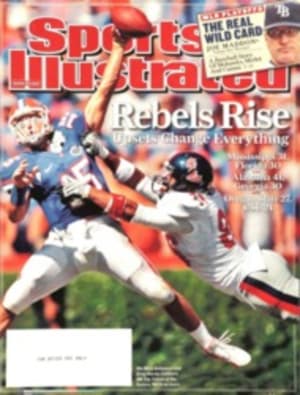
The Latino Athlete Now
ON SATURDAY, Sept. 13, Francisco Rodriguez of the Los Angeles Angels set major league baseball's single-season saves record. That same day USC quarterback Mark Sanchez threw four touchdown passes as the Trojans crushed Ohio State 35--3. And the next day, the eve of the 20th annual celebration of Hispanic Heritage Month in the U.S., Chicago Cubs righthander Carlos Zambrano threw the second no-hitter of the season. Coincidence? Sure. Aberration? Absolutely not. Rewind the clock to Aug. 4, 2007. On that day the New York Yankees' Alex Rodriguez became the youngest player to hit 500 home runs and swimmer Dara Torres set the U.S. record in the women's 50-meter freestyle, and on Aug. 5 golfer Lorena Ochoa won the British Open title.
Every morning sports pages and websites tell of the accomplishments of Latino athletes—those who either come from one of the 20 Latin American countries or are U.S. citizens of Hispanic descent. Once a modest presence in U.S. sports, Latinos are now a force, affecting not only the scores and the record books but also the ways games are played, consumed and marketed. And their influence is being felt well beyond their traditional strongholds of baseball, boxing and soccer.
The NBA, which had one Latino player during the 1979--80 season, finished the '07--08 campaign with 14. San Antonio Spurs swingman Manu Ginobili, born and raised in Argentina, edged Phoenix Suns guard Leandro Barbosa, a Brazilian, for the 2007--08 Sixth Man Award, while Al Horford, born in the Dominican Republic, finished second in Rookie of the Year voting after he helped lead the Atlanta Hawks to their first playoff appearance in nine seasons. Horford had been an example of Latino success in college basketball, too, when he and Florida won their second straight NCAA championship in 2007.
Football? In July 1970, when SPORTS ILLUSTRATED called Minnesota Vikings Super Bowl quarterback Joe Kapp THE TOUGHEST CHICANO IN THE NFL, he didn't have much competition. Only three Latinos were drafted into the league from 1968 to '70. Now there are 25 Latinos in the pro game, including stars such as Kansas City Chiefs tight end Tony Gonzalez, Dallas Cowboys quarterback Tony Romo and Indianapolis Colts wide receiver Anthony Gonzalez.
In golf, meanwhile, Argentina's Angel Cabrera hoisted the U.S. Open trophy in 2007, while Ochoa began the 2008 season by winning six of her first nine starts and leaving no doubt that a 26-year-old native of Guadalajara is the best women's player on the planet.
Teams in Major League Soccer have improved their quality of play by importing ever more players from Latin America. D.C. United's Luciano Emilio, a Brazilian forward, won the 2007 Golden Boot (top scorer), Newcomer of the Year and MVP awards. And David Beckham aside, it's electrifying Latinos such as Chicago Fire striker Cuauhtemoc Blanco and New York Red Bulls forward Juan Pablo Angel who are bringing fans out of their seats.
In baseball there have never been more Rodriguezes and Garcias on the backs of jerseys and at the tops of All-Star ballots. That should come as no surprise, considering that there are more Garcias and Rodriguezes in the U.S., period. Those two names now rank eighth and ninth, respectively, among the most common surnames in the U.S.—the first time two Hispanic names have broken into the top 10. (Martinez, as in Pedro, nearly topped Wilson for the 10th spot.) In the last two decades the U.S. has had its largest influx of immigrants since the early 1900s, with the majority coming from Spanish-speaking countries. The latest census figures indicate that by 2050 the number of Hispanics in the U.S. will nearly triple, to 133 million, and constitute almost one third of the population.
The Latinization of the U.S. isn't evident just in Los Angeles, where 73.7% of public schoolchildren are Hispanic, or in Miami--Dade County, Fla., where more than half the population speaks Spanish at home. It's a factor in Oklahoma, where many of the state's 250,000 Latinos tuned into Spanish-language broadcasts of Sooners football games last year, and in Birmingham, home to the 65-team adult-recreation Latin American Soccer League.
LATIN AMERICA is far from monolithic. The Venezuela of New York Mets ace Johan Santana differs hugely from soccer superstar Lionel Messi's Argentina, which has little in common with Olympic long-jump champion Irving Saladino's Panama. The Spanish language is the closest thing to a connective tissue that Latinos have—unless we're talking about Brazilians, who speak Portuguese. Or we're using the Spanish word ahorita with a Dominican, to whom it means later, or an Ecuadorean, to whom it means now. Or we're considering U.S.-born Hispanics whose immigrant forefathers were so keen on assimilating that they never taught Spanish to their children.
While major league baseball is wildly popular in, say, the Dominican Republic, it doesn't carry the same cultural weight as soccer and boxing in Mexico, the birthplace of some 65% of Latino immigrants in the U.S. This diversity of interests in turn affects how sports and leagues market themselves to Latinos. According to the Selig Center for Economic Growth in Athens, Ga., the buying power of U.S. Hispanics is $862 billion—more than the economies of all but nine countries in 2007. MLS wouldn't survive without this growing market, which constitutes 35% of its fan base. After soccer, Latino fans give their support most to boxing, baseball and the NBA. The NFL, meanwhile, recognizes that to maintain its hegemony in U.S. sports, it must attract Latino fans. It teamed with Spanish-language TV network Univision earlier this year to launch NFLatino.com, which explains basic football rules and features Hispanic players' diaries. Video game maker EA Sports has released Madden NFL 09 En Espa√±ol, complete with the first play-by-play and game analysis in Spanish and with Chicago Bears guard Roberto Garza on the cover.
Because of the Latino influx, our very games have undergone stylistic changes as well. MLS teams have moved away from the British-style airborne attack toward a more Latin American ground game replete with back-heeled passes and multiple fakes. The Argentine team that won the gold medal in Olympic basketball in 2004 reminded the world of the beauty—and efficacy—of selfless team play. Ballplayers from the Dominican Republic and Venezuela continue to set the standard for infield and even outfield play, and the light-hitting, slick-fielding Latino of the past has been joined by Hispanic sluggers such as A-Rod, the Tigers' Magglio Ordo√±ez and the Los Angeles Dodgers' Manny Ramirez.
If Latinization has enriched sports, it has also complicated them. To escape depths of poverty unseen in the U.S. and obtain multimillion-dollar contracts, some Latin American athletes resort to document fraud—usually false birth certificates lowering their ages—and performance-enhancing drugs. Latin-born players have failed doping tests at rates disproportionate to their numbers in baseball. Since January, MLB has suspended 45 Dominican and 15 Venezuelan players for drug-related violations, as opposed to 10 who were U.S. born.
The growing influence of Latino athletes is evident not only at the professional level but also in smaller communities. Canoga Park (Calif.) High, which 30 years ago didn't have a soccer squad, fielded the nation's No. 2 boys' team in 2007, made up mostly of first-generation Americans whose parents are from Mexico, Central America and Colombia. Across the country in Sterling, Va., Dominion High athletic director Joe Fleming gathers more than 60 immigrant students, most of them Latinos, for World Cup Soccer, an intramural program he designed to help students from Spanish-speaking countries fit into their new surroundings. Since starting World Cup Soccer, Fleming says, the failure rate of Hispanic boys at Dominion plummeted 29% from its level of 2004.
The players at Canoga Park and Dominion are certainly not the last Latino arrivals. In previous great waves of immigration to the U.S., the newcomers were often older and came from great distances. Latinos, on the other hand, are the youngest demographic in the U.S., most of them arriving from near the nation's borders. Their influence on sports can be deeper and more lasting than that of the Irish or the Italians before them, forever changing the way games are played.
By the Numbers
36% of U.S. Latinos regularly watch sports
30% of U.S. non-Latinos regularly watch sports
1 of every two people added to the U.S. population, from July 1, 2006, to July 1, 2007, was Hispanic
16 age of Dominican pitcher Michel Inoa in July when the A's gave him a $4.25 million signing bonus
5 of the last 10 AL Cy Young winners were Latino
7 of the last 10 AL MVPs were Latino
89 Years since Dolf Luque became the first Latino to play in a World Series
8.9% of NASCAR fans are Hispanic
9 Pro Bowl selections for Chiefs TE Tony Gonzalez
3 Spanish-language 24-hour sports TV networks in the U.S.
$180 million; amount Arte Moreno spent to buy the Angels in '03
307% increase in Latino buying power from 1990 to 2007
94% of U.S. Latino men say they're sports fans
34 million U.S. residents five or older speak Spanish at home
12.1 million U.S. households watch ESPN Deportes
$43,570 mean income of U.S. Hispanic households
3 of the world's top 10 female surfers are Latinas
47 LPGA victories by golfer Nancy Lopez from 1978 through '93
1 rank, in popularity, of the Yankees among Hispanics
5 of the top 10 World Boxing Organization bantamweights are from Latin America
64.4% of English-dominant Hispanics say they're fans of the NFL
27.6 median age of the U.S. Hispanic population in 2007
36.6 median age of the entire U.S. population in 2007
60% of U.S. Hispanics in 2006 were native-born
3 of the four highest-paid players in MLS are Latino
PHOTO
Photograph by ROBERT BECK
LOS ANGELS As the backs of home-team jerseys in Anaheim attest, Latin American countries are a leading source of imports for the national pastime.
PHOTO
BRIAN KERSEY/MLS/WIREIMAGE.COM (FIRE FANS)
FANS AND FAVES Latinos in the U.S. turn out to root for MLS's Fire (far left) and the NBA's Spurs (far right), while stars such as (from second left to right) Ochoa and '08 Olympic champs Henry Cejudo and Saladino deepen Hispanic influence in golf, wrestling and track and field.
PHOTO
ROBERT BECK (OCHOA)
[See caption above]
PHOTO
BOB MARTIN (CEJUDO)
[See caption above]
PHOTO
ADRIAN DENNIS/AFP/GETTY IMAGES (SALADINO)
[See caption above]
PHOTO
CHRIS BIRCK/NBAE/GETTY IMAGES (SPURS FAN)
[See caption above]

